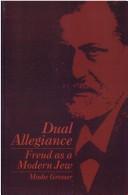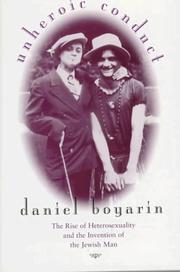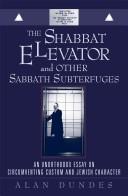| Listing 1 - 10 of 13 | << page >> |
Sort by
|

ISBN: 1438404816 9781438404813 9780791418123 079141812X 0791418111 079141812X 9780791418116 Year: 1994 Publisher: Albany, NY State University of New York Press
Abstract | Keywords | Export | Availability | Bookmark
 Loading...
Loading...Choose an application
- Reference Manager
- EndNote
- RefWorks (Direct export to RefWorks)
Judaism and psychoanalysis. --- Psychoanalysis and Judaism --- Psychoanalysis --- Freud, Sigmund, --- Freud, Sigmund --- Correspondence. --- Religion.
Book
ISBN: 1438427441 1441629718 9781441629715 143842745X 9781438427454 9781438427447 9781438427454 9781438427447 Year: 2009 Publisher: Albany SUNY Press
Abstract | Keywords | Export | Availability | Bookmark
 Loading...
Loading...Choose an application
- Reference Manager
- EndNote
- RefWorks (Direct export to RefWorks)
Is Moses Maimonides an unacknowledged ancestor of the psychoanalytic movement? In this book, David Bakan, Dan Merkur, and David S. Weiss look at the great medieval Jewish philosopher's prescription for the cure of souls and its psychological significance. In the Guide of the Perplexed, Maimonides, who was also a physician, describes the soul's illness: when sinners rationalize evil as good, they limit their capacities to reason, imagine, and behave well, which also produces physical symptoms. The cure depends on repentance in love and fear of God that is attained through philosophical knowledge, the interpretation of dreams and visions, and mystical contemplation. The authors look at the Aristotelian background of Maimonides' psychology, Maimonidean mysticism, his beliefs about prophecy and sexuality, and what is known of Maimonides' client population. A final chapter discusses Maimonides and Freud, noting that many distinctive features of the cure of souls are shared by Freud's original formulation of psychoanalysis. Indeed, the many points of convergence suggest Freud's direct or indirect contact with Maimonides' legacy.
Prophecy --- Meditation --- Soul --- Psychotherapy --- Judaism and psychoanalysis. --- Meditation (Judaism) --- Soul (Judaism) --- Psychoanalysis and Judaism --- Psychoanalysis --- Judaism. --- Religious aspects --- Maimonides, Moses,

ISBN: 0585057176 0520919769 9780520919761 9780585057170 0520210506 Year: 1997 Volume: 8 Publisher: Berkeley University of California Press
Abstract | Keywords | Export | Availability | Bookmark
 Loading...
Loading...Choose an application
- Reference Manager
- EndNote
- RefWorks (Direct export to RefWorks)
The Western notion of the aggressive, sexually dominant male and the passive female, as Daniel Boyarin makes clear, is not universal. Analyzing ancient and modern texts, he recovers the studious and gentle rabbi as the male ideal and the prime object of the female desire in traditional Jewish society. Challenging those who view the "feminized Jew" as a pathological product of the Diaspora or a figment of anti-Semitic imagination, Boyarin finds the origins of the rabbinic model of masculinity in the Talmud. The book provides an unrelenting critique of the oppression of women in rabbinic society, while also arguing that later European bourgeois society disempowered women even further. Boyarin also analyzes the self-transformation of three iconic Viennese modern Jews: Sigmund Freud, Theodor Herzl, and Bertha Pappenheim (Anna O.). Pappenheim is Boyarin's hero: it is she who provides him with a model for a militant feminist, anti-homophobic transformation of Orthodox Jewish society today.
Theological anthropology --- Sex --- Heterosexuality. --- Judaism and psychoanalysis. --- Psychoanalysis and Judaism --- Psychoanalysis --- Sexual orientation --- Man (Jewish theology) --- Judaism. --- Religious aspects

ISBN: 2020058944 9782020058940 Year: 1981 Publisher: Paris: Seuil,
Abstract | Keywords | Export | Availability | Bookmark
 Loading...
Loading...Choose an application
- Reference Manager
- EndNote
- RefWorks (Direct export to RefWorks)
Psychoanalysis --- Judaism --- Psychanalyse --- Congresses --- Essence, genius, nature --- Congrès --- Jews --- Psychology --- Judaism and psychoanalysis --- psychology --- Congrès --- Psychoanalysis and Judaism --- Jews - psychology --- Judaism and psychoanalysis - Congresses --- Congresses.

ISBN: 1461645603 9781461645603 0742516709 9780742516700 0742516717 9780742516717 Year: 2002 Publisher: Lanham, MD
Abstract | Keywords | Export | Availability | Bookmark
 Loading...
Loading...Choose an application
- Reference Manager
- EndNote
- RefWorks (Direct export to RefWorks)
This book focuses on the topic of 'circumventing custom' with special emphasis on the ingenious ways Orthodox (and other) Jews have devised to avoid breaking the extensive list of activities forbidden on the Sabbath. After examining the sources of Sabbath observance as set forth in the Old Testament, the New Testament, and rabbinical writings, some of the most salient forms of circumvention are described. Then drawing on Freud's insights as to the obsessive nature of religious ritual and his persuasive delineation of anal erotic character, an attempt is made to analyze such facets of Jewish ch
Jews --- Judaism and psychoanalysis. --- Prohibited work (Jewish law) --- Sabbath (Jewish law) --- Jewish law --- Prohibited work (Judaism) --- Psychoanalysis and Judaism --- Psychoanalysis --- Psychology.
Book
ISBN: 2246332311 9782246332312 Year: 1984 Publisher: Paris: Grasset,
Abstract | Keywords | Export | Availability | Bookmark
 Loading...
Loading...Choose an application
- Reference Manager
- EndNote
- RefWorks (Direct export to RefWorks)
Judaism and psychoanalysis --- Jews --- Dietary laws --- Psychological aspects --- Psychoanalysis and Judaism --- Hebrews --- Israelites --- Jewish people --- Jewry --- Judaic people --- Judaists --- Dietary laws&delete& --- Psychoanalysis --- Ethnology --- Religious adherents --- Semites --- Judaism --- Jews - Dietary laws - Psychological aspects
Book
ISBN: 9782343217352 2343217351 Year: 2021 Publisher: Paris : L'Harmattan
Abstract | Keywords | Export | Availability | Bookmark
 Loading...
Loading...Choose an application
- Reference Manager
- EndNote
- RefWorks (Direct export to RefWorks)
Psychanalyse --- Judaism and psychoanalysis --- Aspect religieux --- Judaïsme --- Talmud --- Criticism, interpretation, etc. --- Conscience --- Religious aspects&delete& --- Judaism --- Talmud Bavli --- Babylonian Talmud --- Talmud, Babylonian --- Talmud Vavilonskiĭ --- Talmoed, Babylonische --- Babylonische Talmoed --- Shas --- Shishah sedarim --- Talmud of Babylonia --- Talmud de Babilonia --- Talmud Babli --- Talmouth --- Talmod --- Ethics --- Guilt --- Superego --- Psychoanalysis and Judaism --- Psychoanalysis --- 296*22 --- 296*22 Talmud --- Religious aspects
Book
ISSN: 17797365 ISBN: 9782705680862 2705680861 Year: 2011 Publisher: Paris: Hermann,
Abstract | Keywords | Export | Availability | Bookmark
 Loading...
Loading...Choose an application
- Reference Manager
- EndNote
- RefWorks (Direct export to RefWorks)
Dans Totem et Tabou, Freud expliquait pourquoi la mentalité totémique, pour lutter contre les pulsions incestueuses, favorisait le passage à l'acte récidivant et les conduites phobiques. Le titre du présent livre fait écho à l'oeuvre du père de la psychanalyse en raison de l'assimilation, hâtivement faite par certains lecteurs inattentifs, des dispositifs psychiques et juridiques préconisés par la Loi sinaïtique à des montages totémiques et à des interdits « tabous ». Pour réfuter ce préjugé, Raphaël Draï montre que les versets de la Genèse sur « l'Arbre de la connaissance du Bien et du Mal » n'érigent absolument pas cet arbre en totem, ce qui induirait que les dispositifs juridiques et mentaux en cause relèvent du tabou. Si ce récit relate bien l'histoire d'une transgression originelle, et s'il met en évidence les pulsions à l'oeuvre, il détermine également les modalités du travail de ces pulsions, qui resteraient sans cela irrésistibles et mortelles. Fort de cette analyse, l'auteur présente ce qui apparaît comme une véritable théorie, clinique et métapsychologique, des pulsions dans l'oeuvre du Maharal de Prague, et révèle la logique interne qui prédomine, dans les règles alimentaires et les dispositifs juridiques explicités par le droit biblique ainsi que la place centrale qu'occupe le travail sur l'énergie pulsionnelle : sans ré-orientation constante de la pulsion de mort vers la pulsion de vie, il n'y a pas de vie éthique ni de vie en société
Judaism and psychoanalysis --- Religion and Psychology --- Bible --- 159.964.2 --- 222.2 --- Psychoanalysis and Judaism --- Psychoanalysis --- Psychoanalyse --- Genesis --- Bible. --- Chumash --- Five Books of Moses --- Ḥamishah ḥumshe Torah --- Ḥumash --- Kitāb-i Muqqadas --- Mose Ogyŏng (Book of the Old Testament) --- Pentateuch --- Pi︠a︡toknizhīe Moiseevo --- Sefer Ḥamishah ḥumshe Torah --- Tawrāh --- Torà (Pentateuch) --- Torah (Pentateuch) --- Tʻoris xutʻcigneuli --- Ureta --- תורה --- Haftarot

ISBN: 0520200330 0520210506 Year: 1997 Volume: 8 Publisher: Berkeley ; Los Angeles ; London University of California Press
Abstract | Keywords | Export | Availability | Bookmark
 Loading...
Loading...Choose an application
- Reference Manager
- EndNote
- RefWorks (Direct export to RefWorks)
Daniel Boyarin offers an alternative to the prevailing Euroamerican warrior/patriarch model of masculinity and recovers the Jewish ideal of the gentle, receptive male. The Western notion of the aggressive, sexually dominant male and the passive female reaches back through Freud to Roman times, but as Boyarin makes clear, such gender roles are not universal. Analyzing ancient and modern texts, he reveals early rabbis--studious, family-oriented--as exemplars of manhood and the prime objects of female desire in traditional Jewish society [publisher's description]
Sexology --- Jewish religion --- Sex --- -Theological anthropology --- -Heterosexuality --- Judaism and psychoanalysis --- Psychoanalysis and Judaism --- Psychoanalysis --- Sexual orientation --- Anthropology, Doctrinal --- Anthropology, Theological --- Body and soul (Theology) --- Doctrinal anthropology --- Humanity, Doctrine of --- Man, Doctrine of --- Man (Theology) --- Mankind, Doctrine of --- Religion --- Gender (Sex) --- Human beings --- Human sexuality --- Sex (Gender) --- Sexual behavior --- Sexual practices --- Sexuality --- Religious aspects --- -Judaism --- Judaism --- Heterosexuality. --- Judaism and psychoanalysis. --- Theological anthropology --- Judaism. --- Heterosexualiteit --- Heterosexuality --- Homme (Théologie juive) --- Hétérosexualité --- Jodendom en psychoanalyse --- Judaïsme et psychanalyse --- Man (Jewish theology) --- Mens (Joodse theologie) --- Sexualiteit [Hetero] --- Sexualité [Hétéro] --- Religious aspects&delete&
Book
ISBN: 0422617601 0422613800 Year: 1987 Volume: vol *2 Publisher: London : Tavistock,
Abstract | Keywords | Export | Availability | Bookmark
 Loading...
Loading...Choose an application
- Reference Manager
- EndNote
- RefWorks (Direct export to RefWorks)
Complexe d'Oedipe --- Edipus complex --- Jodendom en psychoanalyse --- Judaism and psychoanalysis --- Judaïsme et psychanalyse --- Oedipe [Complexe d' ] --- Oedipus complex --- Oedipuscomplex --- Judaism. --- Psychoanalytic Theory. --- Sexual Behavior. --- Women --- Premarital Sex Behavior --- Sex Behavior --- Sex Orientation --- Sexual Activities --- Anal Sex --- Oral Sex --- Sexual Activity --- Sexual Orientation --- Activities, Sexual --- Activity, Sexual --- Behavior, Premarital Sex --- Behavior, Sex --- Behavior, Sexual --- Orientation, Sexual --- Sex, Anal --- Sex, Oral --- Sex --- Reproductive Behavior --- Psychoanalytical Theory --- Theory, Psychoanalytic --- Oral Character --- Character, Oral --- Characters, Oral --- Oral Characters --- Psychoanalytic Theories --- Psychoanalytical Theories --- Theories, Psychoanalytic --- Theories, Psychoanalytical --- Theory, Psychoanalytical --- Jewish Ethics --- Ethic, Jewish --- Ethics, Jewish --- Jewish Ethic --- Jews --- psychology. --- Judaism --- Women in Judaism --- Psychoanalytic Theory --- Sexual Behavior --- Complexes (Psychology) --- Electra complex --- Mothers and sons --- Parent and child --- Psychoanalysis --- Psychology, Pathological --- Sex (Psychology) --- Psychoanalysis and Judaism --- Influence --- psychology --- Freud, Sigmund, --- Freud, Sigmund --- Relations with women. --- Views on female sexuality --- Relations with women --- Freud, Sigmund, 1856-1939 - Views on female sexuality. --- Freud, Sigmund, 1856-1939 - Relations with women. --- Oedipus complex. --- Judaism - Influence. --- Judaism and psychoanalysis. --- Women in Judaism.
| Listing 1 - 10 of 13 | << page >> |
Sort by
|

 Search
Search Feedback
Feedback About UniCat
About UniCat  Help
Help News
News